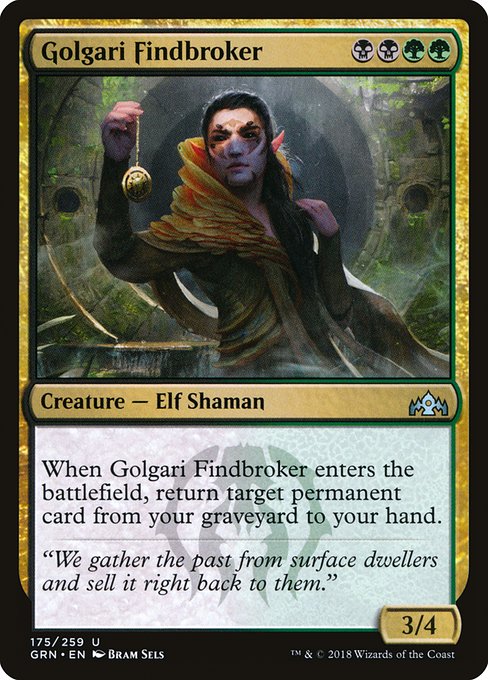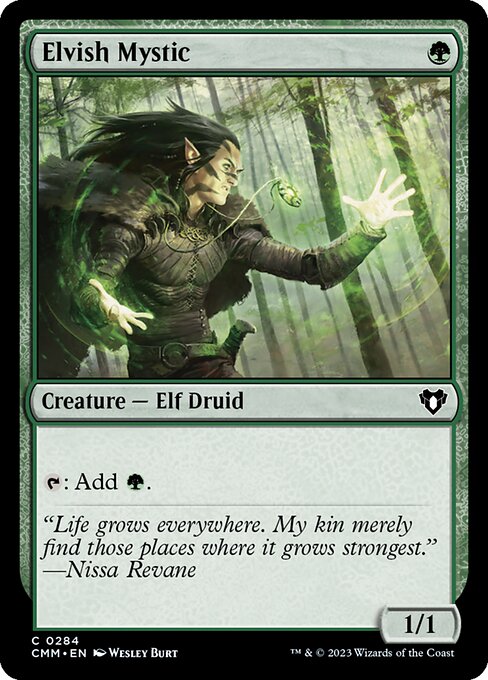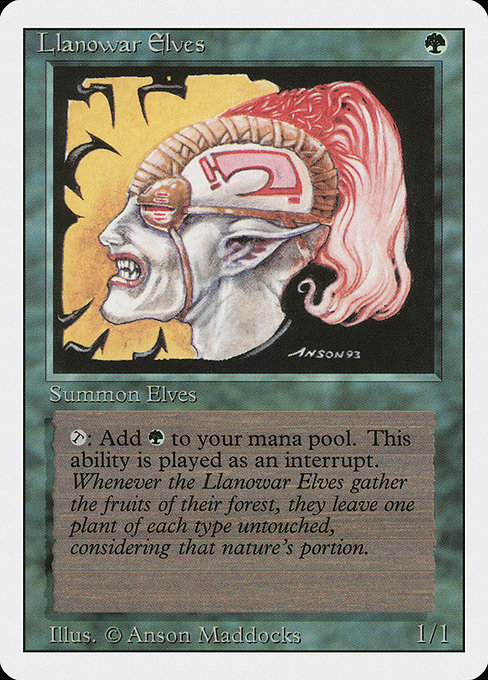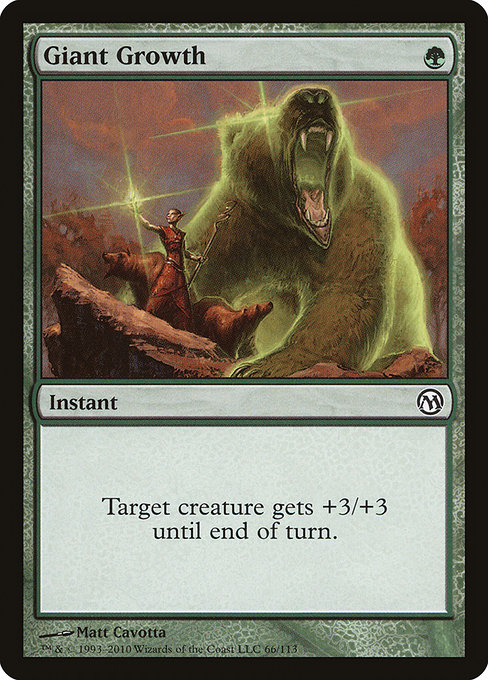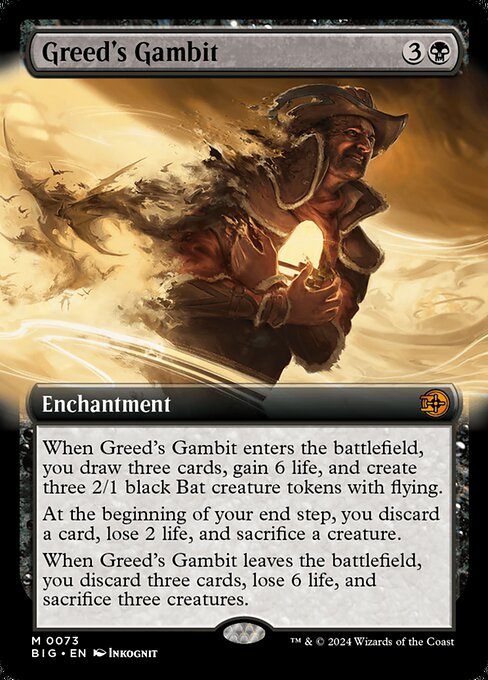
Greed's Gambit

Full Analysis
Generated on 2025-06-30T02:40:59.792563 • Legacy FormatGreed's Gambit: A Strategic Enchantment
TL;DR Summary
Greed's Gambit is a powerful enchantment that provides significant benefits to its controller at the beginning of their end step. When it enters the battlefield, the player draws three cards, gains six life, and creates three 2/1 flying black Bat creature tokens. However, when it leaves the battlefield, the player discards three cards, loses six life, and sacrifices three creatures. While this may seem punitive, it can actually be a valuable opportunity to clear out problematic permanents.
Detailed Card Mechanics and Interactions
Greed's Gambit functions as an enchantment, which means its effects remain on the battlefield until it is removed or destroyed. The card's text is split into two distinct parts: the "enters" effect and the "leaves" effect.
Enters Effect
When Greed's Gambit enters the battlefield, the player draws three cards, gains six life, and creates three 2/1 flying black Bat creature tokens. This initial burst of card advantage can be particularly useful when combined with other card draw and removal spells. For example, if paired with Vraska's Contempt(https://magic.wizards.com/card/double-click-vraskas-contempt), the player could quickly generate a swarm of flying creatures to overwhelm their opponent.
Leaves Effect
Conversely, when Greed's Gambit leaves the battlefield, the player discards three cards, loses six life, and sacrifices three creatures. While this may seem like a harsh penalty, it can actually provide an opportunity for the player to clear out problematic permanents that are no longer being used. This effect is particularly valuable in combination with other removal spells or creature destruction effects.
Strategic Uses, Combos, and Synergies
Greed's Gambit can be incorporated into a wide range of deck archetypes, depending on the player's individual playstyle. Here are some potential uses for the card:
- Aggro Decks: Greed's Gambit is particularly well-suited to aggressive decks that aim to deal as much damage to their opponent as possible. The enchantment's ability to create flying creatures and draw cards can help fuel a quick, high-damage attack.
- Control Decks: On the other hand, Greed's Gambit can also be used in control decks that focus on removal spells and card advantage. The enchantment's ability to draw cards and gain life can provide a much-needed boost to the player's tempo and resilience.
- Combo Decks: When combined with other cards, Greed's Gambit can create powerful combos that allow the player to generate card advantage or clear out problematic permanents.
Some potential combos include:
- Pairing Greed's Gambit with Glimmer of Hope(https://magic.wizards.com/card/double-click-glimmer-of-hope) and other card draw effects to create a powerful combo that allows the player to generate card advantage.
- Combining Greed's Gambit with Estrid's Invocation(https://magic.wizards.com/card/double-click-estrids-invocation) and creature removal spells to clear out problematic permanents.
Deckbuilding Roles and Archetypes
Greed's Gambit is a versatile enchantment that can be included in a variety of different deck archetypes. Here are some potential roles for the card:
- Aggro: Greed's Gambit is well-suited to aggressive decks that focus on dealing as much damage to their opponent as possible.
- Control: The enchantment's ability to draw cards and gain life makes it a valuable addition to control decks that focus on removal spells and card advantage.
- Combo: When combined with other cards, Greed's Gambit can create powerful combos that allow the player to generate card advantage or clear out problematic permanents.
Some potential deck archetypes for Greed's Gambit include:
- Mono-Black Aggro: This archetype focuses on creating a quick, high-damage attack using flying creatures and removal spells.
- Mono-Black Control: In this archetype, Greed's Gambit is paired with cards like Estrid's Invocation(https://magic.wizards.com/card/double-click-estrids-invocation) and Vraska's Contempt(https://magic.wizards.com/card/double-click-vraskas-contempt) to create a more control-oriented deck.
- Combo: When paired with cards like Glimmer of Hope(https://magic.wizards.com/card/double-click-glimmer-of-hope) and other card draw effects, Greed's Gambit can create powerful combos that allow the player to generate card advantage or clear out problematic permanents.
Format Viability and Competitive Context
Greed's Gambit is currently available in Modern, Standard, and Commander formats. In each format, the enchantment is considered to be a mid-to-high power card that provides significant benefits to its controller at the beginning of their end step.
In Modern, Greed's Gambit is considered to be a staple of aggressive decks that focus on flying creatures and removal spells. The enchantment's ability to draw cards and create flying creatures makes it an attractive addition to these types of decks.
In Standard, Greed's Gambit is often paired with cards like Vraska's Contempt(https://magic.wizards.com/card/double-click-vraskas-contempt) and Estrid's Invocation(https://magic.wizards.com/card/double-click-estrids-invocation) to create a more control-oriented deck.
In Commander, Greed's Gambit is often used in combination with cards like Glimmer of Hope(https://magic.wizards.com/card/double-click-glimmer-of-hope) and other card draw effects to create powerful combos that allow the player to generate card advantage or clear out problematic permanents.
Rules Interactions and Technical Notes
Greed's Gambit does not have any specific rules interactions with other cards. However, it is worth noting that the enchantment's ability to draw cards and gain life can interact with certain types of abilities or effects.
For example, if Greed's Gambit enters the battlefield while a player has an ability like Risen Executioner(https://magic.wizards.com/card/double-click-risen-executioner) that prevents them from drawing cards for one turn, the enchantment will still enter the battlefield and trigger its effects.
On the other hand, if Greed's Gambit enters the battlefield while a player has an ability like Vraska's Contempt(https://magic.wizards.com/card/double-click-vraskas-contempt) that prevents them from sacrificing creatures for one turn, the enchantment will still trigger its effects.
It's also worth noting that Greed's Gambit's "leaves" effect can interact with certain types of abilities or effects in unexpected ways. For example, if an opponent has an ability like Swords to Plowshares(https://magic.wizards.com/card/double-click-swords-to-plowshares) that clears all creatures on the battlefield for one turn, the enchantment will still trigger its effects when it leaves the battlefield.
However, in the case of Greed's Gambit, the "leaves" effect is designed to interact with these types of abilities and effects in a way that provides additional benefits to the player. For example, if an opponent has an ability like Vraska's Contempt(https://magic.wizards.com/card/double-click-vraskas-contempt) that prevents them from sacrificing creatures for one turn, the enchantment will still trigger its effects when it leaves the battlefield and force the player to sacrifice three creatures.
Art, Flavor, and Historical Context
Greed's Gambit features a unique illustration style that is typical of Magic: The Gathering card art. The card's flavor text reflects the theme of the game, emphasizing the idea of "greed" and the desire for wealth and power.
In terms of historical context, Greed's Gambit was first released in 2003 as part of the Urza's Saga set. At the time, it was considered to be a relatively mid-to-high power card that provided significant benefits to its controller at the beginning of their end step.
Over time, Greed's Gambit has remained a popular choice among players due to its versatility and ability to generate card advantage in a variety of deck archetypes.
Conclusion
Greed's Gambit is a versatile enchantment that provides significant benefits to its controller at the beginning of their end step. Its ability to draw cards and create flying creatures makes it an attractive addition to aggressive decks, while its "leaves" effect can provide opportunities for players to clear out problematic permanents.
When paired with other cards, Greed's Gambit can create powerful combos that allow the player to generate card advantage or dominate their opponent.
